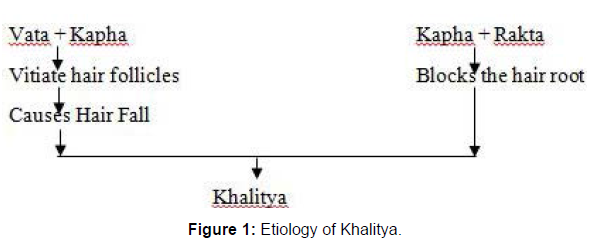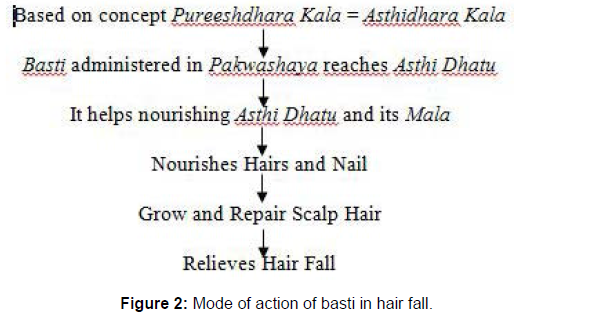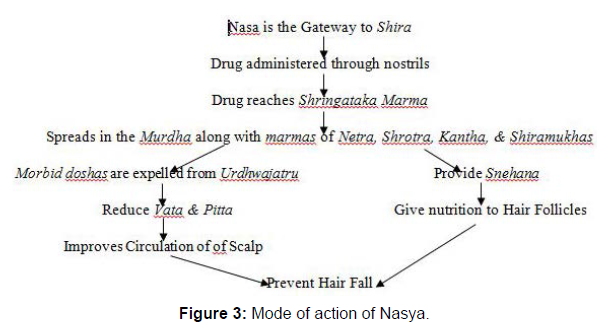Mode of Action of Nasya Karma and Basti Chikitsa in Hair Fall: A Review Article
Received: 22-Jan-2022 / Manuscript No. jham-22-52193 / Editor assigned: 24-Jan-2022 / PreQC No. jham-22-52193(PQ) / Reviewed: 07-Feb-2022 / QC No. jham-22-52193 / Revised: 11-Feb-2022 / Manuscript No. jham-22-52193 (R) / Accepted Date: 15-Feb-2022 / Published Date: 17-Feb-2022 DOI: 10.4172/2573-4555.1000305
Abstract
There is a famous quote “A thing of beauty is joy Forever”. Healthy, Beautiful, long, lustrous and attractive hairs always add charm to the personality. That is why, to keep the hairs in healthy state is entirely the duty of human beings, because just like face, Hair is also a mirror of healthy state of the body. Hair Fall is a silent but terrifying problem which may occur to a healthy person also. It is as a geriatric physiological phenomenon, which occurs generally after the mid-forties, but it is considered as a disease if it occurs before this period. In Ayurveda, it is believed that Kesha (Hair) are Mala (byproduct) of Asthi Dhatu (Bone). Hair fall is described by name Khalitya Roga under the chapter of Kshudra Roga (minor diseases) in Sushrutu Samhita and under Shiroroga (Disease of Head) by Vagbhatta. There are scattered reference in Ayurveda about Etiological Factors of Khalitya and different Panchakarma procedures which can prevent Hair Fall. Nasa (Nose) is considered as the Gateway of Shirah Pradesh (Head Region) and Nasya Karma is mentioned as choice of management of Urdhwajatrugata Vyadhi including Hair fall. Basti Chikitsa is referred as Ardhachikitsa (Half of the treatment of all disease). Basti Karma can directly improve production of Asthi Dhatu and its Mala – Kesha as Pureeshadharakala and Asthidharakala are interrelated by Ashryaashrayi relation. It can be helpful in nourishing hair follicles and prevent hair fall. In present article, we have reviewed the mode of action of Nasya Karma and Basti Chikitsa that how they could help in preventing hair fall and nourishing hair follicles.
Keywords: Ashryaashrayi relation; Asthi Dhatu; Asthidharakala; Basti Chikitsa; Kesha; Khalitya; Nasya Karma; Pureeshadharakala, Shirah Pradesh; Urdhwajatrugata Vyadhi
Keywords
Ashryaashrayi relation; Asthi Dhatu; Asthidharakal; Basti Chikitsa; Kesha; Khalitya; Nasya Karma; Pureeshadharakala, Shirah Pradesh; Urdhwajatrugata Vyadhi
Introduction
Hair fall is one of the most common problems among all age groups. According to Modern Science Hair Fall is not a disease but just a symptom, which triggers according to its causative factors. Some common causative factors include Sebaceous Glands Obstruction, Climate change, Improper hair care, Hair cycle disturbance due to Endocrine origin, Chemical Origin, Nutrition and metabolic origin, Mental Stress, Pregnancy or any other disease origin [1].
Normally, 25-100 hairs shed every day which is Six to eight percent of hair in the scalp [2]. This is non-pathological. Pathological hair loss occurs as a result of degradation to the hair follicles. The hair follicle is responsible for hair growth. Therefore, anything that affects the hair follicles may cause premature loss of hair. For the hair follicle to function well, it should receive adequate amounts of nutrients which require good blood supply to the scalp. Anything that impairs scalp blood supply can cause hair loss.
In Ayurveda, Hair Fall has been described by different Acharyas as Khalitya Disease. It is included under Kshudra Roga due to mildness of disease [3]. Ashtang hridayakara included this disease in Shiroroga [4]. It is primarily a Pitta predominant Tridoshajanya Vyadhi i.e Vata, Pitta, Kapha along with Rakta dosha. First, the Vata and Pitta gets vitiate and affects hair follicles (Romakupa), it causes gradual falling of hairs. Then Kapha along with Rakta blocks the hair root, and prevent further growth of fresh hairs [3]. This leads to baldness (Figure 1).
According to Acharya Charaka, the Tejas Dhatu (heat of body) of the body in association with Vayu and other Dosha, scorches up the hair-root (scalp) giving instantaneous rise to alopecia (Khalitya) in man [5]. Chakrapani, while commenting on this, points out that Dehoshma is to be understood by the word Teja and Dehoshma is directly proportional to Pitta [6].
Acharya Vagbhatta has mentioned symptoms of Khalitya due to different Dosha. When Khalitya is due to Vata it causes burning over scalp; when due to Pitta it causes sweating and when due to Kapha it causes thickening of skin [7].
Origin of Hairs
According to the Ayurveda physiology human body has seven Dhatus i.e. Rasa, Rakta, Mamsa, Meda, Asthi, Majja and Shukra. As Dugdha gets converted to Dahi, Dahi to Navneeta, Navneeta to Grihta and from Grihta gets converted to Grhtamanda step wise, similar concept is for Dhatu formation. This concept is called Ksheer Dadhi Nyaya.
Dhatvagni (fire of body) converts Ahara and each Dhatu into next Dhatu, its Updhatu and Mala i.e. Rasagni turns Ahara (food) into Rasa Dhatu, its Updhatu - Stanya, Artava and Mala - Kapha.
During Dhatu Nirmana process, when metabolism of Meda Dhatu occur by its own Agni, Asthi Dhatu emerges from Sara part and at the same time Kesha, Loma, Nakha i.e. hair of scalp & body and nails form as Mala of Asthi Dhatu [8]. Maximum Acharyas has considered hairs as the mala (byproduct) of the Asthi Dhatu (bones). Tissues which are responsible for building bones are also responsible for the growth of the hairs.
Discussion
Basti Karma
Pakwashaya (large intestine) is considered as one of the Ashaya by Sushruta [9]. and Vagbhatta [10]. Charaka has considered it as one of the Koshthanga.
According to Sushruta, Pureesha dhara kala is Panchamee Kala which exists in Pakvashaya. But mainly it is lined Pakwashaya internally from Unduka (Caecum) to Guda (Anal region). Functionally it separates constituents of Kitta or waste products present in Unduka and Colon. This Kala is also known by name ‘Maladhara Kala’[11].
Acharya Dalhana has mentioned that Pureeshadhara Kala and Asthidhara Kala are interrelated by Ashryaashrayi relation. So, it can be assumed that drug acting upon Pureeshadhara Kala will certainly act on the Asthidhara Kala [12]. Hence, Basti will help in nourishment of Asthi Dhatu and its Mala i.e. Kesha ultimately resulting in repair and growth of hair of body and scalp (Figure 2).
Nasya Karma
Administration of Nasya in proper time with proper method keeps eyes, ears and nose of the person healthy. The hair of that person does not turn grey and one does not suffer from hair falling problem, instead hair growth is also accelerated [13]. Acharya Vagbhatta has mentioned that Shamana Nasya is useful for Kesha Roga (Hair Fall and Greying of Hair) [14]. Acharya Charak and Vagbhatta has considered nose as a route for drug administration to Shirah Pradesh (Head). And that in all Urdhwajatrugata Roga (Head and Neck diseases) Nasya Karma is the choice of management [15]. (Figure 3).
Excess of Pitta in the sebaceous gland at the root of the hairs may cause hair fall. Yashtimadhukaadi Tail [16]. Contains mainly Pitta Shamaka drugs (Yashtimadhuka and Amalaki) which helps in breaking Samprapti (pathophysiology) of Khalitya (Hair Fall). Ksheera used during Taila Paaka would help in further nourishment of hair follicles and helps in their regrowth.
Conclusion
According to Ayurveda, vitiation of Vata and Pitta Dosha are the main cause of Hair Fall. Vata get aggravated by its Ruksha and Khara Guna and Pitta by Usna Guna. Pitta and Vata vitiation lead to increase in Dehoshama & Bhrajak Pitta Dushti which scorches up the Keshabhoomi. Yashtimadhukaadi Tail Nasya contains Yashtimadhu (Glycirhhiza glabra) and Amalaki (Emblica ribes). These are Sheeta dravyas and will help in pacifying Pitta Dosha. Sneha guna of Tail will act as Vata and Kapha Shamaka. Ksheer guna present in it will provide nourishment to scalp. Nasya being the nearest root of Scalp will subside the cause of Khalitya and Basti will provide overall nutrition (Shamana and Brumhana Karma) which will nourish Hair Follicles.
References
- Asghar F, Shamim N, Farooque U, Sheikh H, Aqeel R. (2020) Telogen Effluvium: A Review of the Literature. Cureus 12:8320.
- Rebora A (2019) Telogen effluvium: a comprehensive review. Clin Cosmet Investig Dermatol 12:583-590.
- Susruta Samhita of Maharsi Susruta Edited With Ayurveda-Tattva-Sandipika ( 2015) Kaviraja Ambikadutta Shastri part 1, Chaukhambha Sanskrit Sansthan, Edition; Reprint 2015, 32-33: 368.
- Kaviraja Atrideva Gupta, (2018) AstangaHrdayam of Vagbhata Edited with ‘Vidyotini’ Hindi commentary, Chaukhabha Prakashan, Edition: Reprint 2018, India, Shirorogavigyaniya adhyaya shlok 24-26:728.
- Kashinath S, Gorakhnath C, (2015) Charaka Samhita of Agnivesha revised by Charaka and Dradhabala with Viddyotini Hindi Commentary, Chaukhambha Prakashan, Edition: 2019, India, Trimarmiyachikitsa adhyaya shlok 132:744.
- B.L.Dwivedi, Pradip KG (2014) Ayurvedadipika (Sanskrit Commentary), CHaukhamba Krishnadas Academy, Edition 2020, India, shlok 26/132:869.
- Atrideva G, Chaukhabha P (2016) AstangaHrdayam of Vagbhata Edited with ‘Vidyotini’ Hindi commentary, Edition: Reprint 2018, India, 27-28:728.
- Kashinath S, Gorakhnath C (2015) Charaka Samhita of Agnivesha revised by Charaka and Dradhabala with Viddyotini Hindi Commentary, Chaukhambha Prakashan, Edition: Reprint 2019, India, 30-31:458.
- Ambikadutta S (2019) Susruta Samhita of Maharsi Susruta edited with Ayurveda-tattva-Sandipika, Chaukhambha Sanskrit Sansthan, Varanasi, Edition; Reprint 2015, India, 8:55.
- Atrideva G, Chaukhabha P (014) AstangaHrdayam of Vagbhata Edited with ‘Vidyotini’ Hindi commentary, Edition: Reprint 2018, India, 10 -11:251.
- Ambikadutta S (2019) Susruta Samhita of Maharsi Susruta edited with Ayurveda-tattva-Sandipika, Edition; Reprint 2015, India, 16-17:40.
- Jadavji T (2018) Shri Dalhanacharya 5 Kalpasthana, Sushruta Samhita with Nibandhasangraha Commentary, Chaukhamba Subharti Prakashana, Edition; Reprint 1994, 44:470.
- Kashinath S, Gorakhnath C Charaka Samhita of Agnivesha revised by Charaka and Dradhabala with Viddyotini Hindi Commentary, Chaukhambha Prakashan, Edition: Reprint 2015, India, 57 – 59:123.
- Atrideva G (2011) AstangaHrdayam of Vagbhata Edited with ‘Vidyotini’ Hindi commentary, Chaukhabha Prakashan, Edition: Reprint 2018, India, 4:172.
- Atrideva G (2011) AstangaHrdayam of Vagbhata Edited with ‘Vidyotini’ Hindi commentary, Chaukhabha Prakashan, Edition: Reprint 2018, India, 1:172.
- Indradeva T, Chakradutta of Shri Chakrapanidatta with Vaidayaprabha Hindi Commentary, Chaukhambha Sanskrit Bhawan, Edition: Reprint 2019, India, 111:321.
Indexed at, Google Scholar, Crossref
Indexed at, Google scholar, Crossref
Citation: Parvez N, Mishra S (2022) Mode of Action of Nasya Karma and Basti Chikitsa in Hair Fall: A Review Article. J Tradit Med Clin Natur, 11: 305. DOI: 10.4172/2573-4555.1000305
Copyright: © 2022 Parvez N, et al. This is an open-access article distributed under the terms of the Creative Commons Attribution License, which permits unrestricted use, distribution, and reproduction in any medium, provided the original author and source are credited.
Select your language of interest to view the total content in your interested language
Share This Article
Recommended Journals
Open Access Journals
Article Tools
Article Usage
- Total views: 5579
- [From(publication date): 0-2022 - Jun 15, 2025]
- Breakdown by view type
- HTML page views: 4925
- PDF downloads: 654



